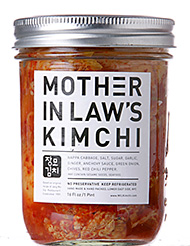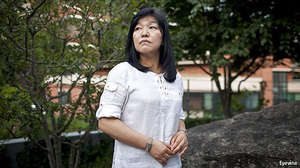The first offerings of artisan kimchi comprise the most popular recipes: napa cabbage and daikon (the long, white East Asian radish).
Open the mason jar just a tad and the pungent aroma of kimchi wafts out.
Napa Cabbage Kimchi. Leaves of cabbage marinated in a sauce of red chiles, onion, scallion, chives, salt, sugar, garlic, ginger, anchovy sauce, oysters, salted shrimp, beef stock, sesame seeds and rice flour.
Daikon Kimchi. Crunchy cubes of daikon are easier to eat without dripping the sauce, made of red chiles, onion, scallion, chives, garlic, salted shrimp and beef stock. All flavors combine on the palate: chile flavor (and heat), garlic and approximation of citrus, which isn't an ingredient.

Lauryn Chun, a former wine consultant and founder of Mother In Law's Kimchi, spent nine years ferrying kimchi from her mother's restaurant--Jang Mo Gip in Garden Grove, a city in Orange County, California--to her home in New York City. Her friends couldn't get enough of it. Then the light bulb went on--BUSINESS OPPORTUNITY!--and she began to produce artisan kimchi locally, using her mother's recipe plus napa cabbage and daikon grown by a Korean farmer in New York's Mid-Hudson Region.
1, 2.





